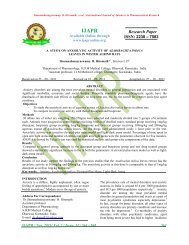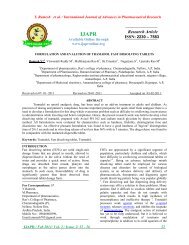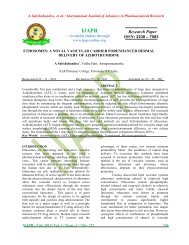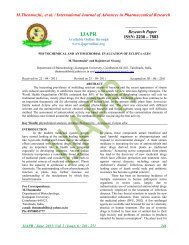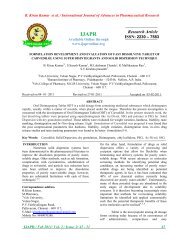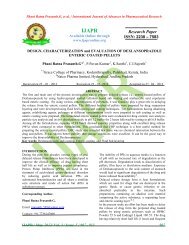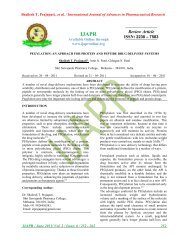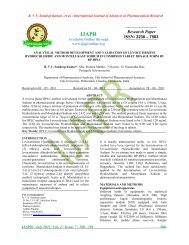20110217_venkatalakshmi et al IJAPR_2.pdf - international journal ...
20110217_venkatalakshmi et al IJAPR_2.pdf - international journal ...
20110217_venkatalakshmi et al IJAPR_2.pdf - international journal ...
You also want an ePaper? Increase the reach of your titles
YUMPU automatically turns print PDFs into web optimized ePapers that Google loves.
K. Venkata Lakshmi* <strong>et</strong> <strong>al</strong>. / Internation<strong>al</strong> Journ<strong>al</strong> of Advances in Pharmaceutic<strong>al</strong> Research<br />
<strong>IJAPR</strong><br />
Available Online through<br />
www.ijapronline.org<br />
Research Paper<br />
ISSN: 2230 – 7583<br />
STUDIES ON ANTI-STRESS ACTIVITY OF SEEDS AQUEOUS EXTRACT OF<br />
CUMINUM CYMINUM LINN.<br />
K.Venkata Lakshmi *1 , R.V.Karadi 1 , K.M<strong>al</strong>likarjuna Rao 2 , E.N.Gaviraj 1 , G.Ulab S Shinde, Pravin J Dere<br />
,<br />
1 Department of Pharmacognosy and Phytochemistry, K. L. E.S’s College of Pharmacy,<br />
Belgaum – 590 010, Karnataka, India.<br />
2 Department of Pharmaceutics. Ratnam Institute of Pharmacy, Pidathapolur, Nellore,<br />
A.P, India.<br />
Received on 30-12-2010 Revised on 17-01-2010 Accepted on 29-01-2010<br />
ABSTRACT<br />
The present work was to ev<strong>al</strong>uate the anti-stress activity of Cuminum cyminum linn seeds<br />
extract by using Swim Endurance test. Aqueous extract of Cuminum cyminum linn were tested for<br />
various preliminary phytochemic<strong>al</strong> constituents and were screened for anti-stress activity. Proteins,<br />
flavonoids, amino acids and phenolic compounds were found to be present in aqueous extract of<br />
Cuminum cyminum linn with the help of phytochemic<strong>al</strong> screening. The anti-stress activity of the<br />
aquesous extract of Cuminum cyminum linn have the significant v<strong>al</strong>ues at a dose of 400mg, when<br />
compared to the standard mark<strong>et</strong>ed available drug.<br />
Keywords: Cuminum cyminum, Phytochemic<strong>al</strong> Screening, Kaempferol, Anti-stress activity , Swim<br />
Endurance test<br />
INTRODUCTION<br />
The Medicin<strong>al</strong> plants have been<br />
regarded as sacred and used by early<br />
civilizations to treat sickness and to embellish<br />
mans well being. 1 It has been estimated that<br />
from 25,000 to 75,000 species of higher plants<br />
exist on the earth. A reasonable estimate of<br />
about 10% has been used in tradition<strong>al</strong><br />
medicine. However perhaps only about 1% of<br />
these (250-750 species) are acknowledged<br />
through scientific studies to have therapeutic<br />
v<strong>al</strong>ue when used in extract form by human. 2<br />
For Correspondence*<br />
K.Venkat<strong>al</strong>akshmi, M.Pharm.,<br />
Department of Pharmacognosy,<br />
K.L.E.S’s College of Pharmacy,<br />
Belgaum – 590010,<br />
Karnataka, India<br />
Mobile No:- 09533334922.<br />
Stress can be defined as aversive stimulus<br />
which perturbs the physiologic<strong>al</strong> homeostasis<br />
of the organisms and its impact is reflected on<br />
a vari<strong>et</strong>y of biologic<strong>al</strong> systems. Many stressful<br />
conditions are reported to modify host<br />
resistance to a vari<strong>et</strong>y of illness including<br />
<strong>al</strong>lergic and infectious disorders by influencing<br />
the immune processes of the individu<strong>al</strong>. 3<br />
Spices form an important class of<br />
food adjuncts in human di<strong>et</strong>. Besides<br />
enhancing the taste and flavour of foods,<br />
spices exhibit a wide range of physiologic<strong>al</strong><br />
and pharmacologic<strong>al</strong> properties. Cuminum<br />
cyminum (Linn.) belonging to the family<br />
Umbelliferae is widely used in ayurveda for<br />
the treatment of dyspepsia, diarrrhoea and<br />
jaundice. C.cyminum linn seeds have long been<br />
considered stimulant, carminative, stomachic<br />
and astringent. 4 Although tradition<strong>al</strong>ly the<br />
seeds extract of C.cyminum linn have been<br />
reported for its antiulcer and antistress<br />
properties 5 , no studies have shown its antiulcer<br />
and antistress promoting activity. In view of<br />
this folklore claim, the present study has been<br />
undertaken to ev<strong>al</strong>uate in d<strong>et</strong>ail the antiulcer<br />
and antistress activities of seeds of C.cyminum.<br />
MATERIALS AND METHODS<br />
Plant materi<strong>al</strong><br />
<strong>IJAPR</strong> / January 2011/ Vol. 2 / Issue. 1/ 41 - 44 41
K. Venkata Lakshmi* <strong>et</strong> <strong>al</strong>. / Internation<strong>al</strong> Journ<strong>al</strong> of Advances in Pharmaceutic<strong>al</strong> Research<br />
The seeds of Cuminum cyminum (Linn.) were<br />
collected from the loc<strong>al</strong> mark<strong>et</strong> in Belgaum<br />
and authenticated by Prof. R.S.Goudar,<br />
Department of Botany, KLES’s Raja<br />
Lakhamagouda Science Institute, Belgaum,<br />
Karnataka.<br />
Extraction<br />
Seeds were dried in shade, powdered<br />
and subjected to Soxhl<strong>et</strong>-extraction with<br />
p<strong>et</strong>roleum <strong>et</strong>her, chloroform, m<strong>et</strong>hanol, 70%<br />
<strong>et</strong>hanol and water. The extractive matter was<br />
evaporated with the use of different m<strong>et</strong>hod.<br />
The individu<strong>al</strong> extractive matter was stored in<br />
separate containers for feature use. The extract<br />
was suspended in water using Tween 80 as a<br />
suspending agent for the purpose of or<strong>al</strong><br />
administration. 6<br />
Preliminary phytochemic<strong>al</strong> investigation<br />
Qu<strong>al</strong>itative chemic<strong>al</strong> tests were<br />
conducted for <strong>al</strong>l the extracts of seeds of<br />
Cuminum cyminum (Linn.) to identify the<br />
various phytoconstituents. The various tests<br />
and reagents used for the identification of<br />
chemic<strong>al</strong> constituents. Phytochemic<strong>al</strong><br />
screening of the aqueous extract reve<strong>al</strong>ed the<br />
presence of phenolic compounds, flavonoids,<br />
proteins and aminoacids 6 .<br />
Experiment<strong>al</strong> anim<strong>al</strong>s<br />
M<strong>al</strong>e <strong>al</strong>bino rats of body weight 150-200 g<br />
were selected for the experiment. Anim<strong>al</strong>s<br />
were kept in anim<strong>al</strong> house at an ambient<br />
temperature of 25–30 0 C and 45–55% relative<br />
humidity with a 12 hr light: dark cycle.<br />
Anim<strong>al</strong>s were fed pell<strong>et</strong> di<strong>et</strong> (Amrut, Sang<strong>al</strong>i)<br />
and water ad libitum.<br />
Swim Endurance Test 7<br />
Swiss <strong>al</strong>bino mice (25+2g) of either<br />
sex were used for swim endurance. The norm<strong>al</strong><br />
anim<strong>al</strong>s were treated with norm<strong>al</strong> s<strong>al</strong>ine<br />
(1ml/rat p.o), second group with Geriforte, an<br />
Ayurvedic formulation (300mg/kg b.w.) and<br />
other ten groups with their respective seed<br />
extracts of 200 and 400mg/kg b.w. for 14 days.<br />
On day 14, mice were <strong>al</strong>lowed to swim in<br />
cylindric<strong>al</strong> container (diam<strong>et</strong>er 10cm, height<br />
25cm), containing 19cm of water maintained<br />
at (25+1 0 c) till they got exhausted 8 and the<br />
moment they drowned was considered as the<br />
endpoint “Swimming Time” .9<br />
Anoxic Stress Tolerance Test 7<br />
Anoxia is a very severe stressor. All<br />
the body functions, including cellular<br />
respiration depends on oxygen supply to them.<br />
Lack of this vit<strong>al</strong> element will cause <strong>al</strong>l the<br />
vit<strong>al</strong> functions of the body to cease. Swiss<br />
<strong>al</strong>bino mice (25±2g) of either sex were used<br />
for anoxia stress tolerance test. The control<br />
anim<strong>al</strong>s were treated with norm<strong>al</strong> s<strong>al</strong>ine<br />
(1ml/kg b.w.p.o), second group with Geriforte,<br />
an Ayurvedic formulation (300mg/kg b.w.p.o.)<br />
and other ten groups with their respective seed<br />
extracts (200 and 400mg/kg b.w.p.o.) for 21<br />
days. Conic<strong>al</strong> flasks of 250 ml capacity were<br />
used for the study. These flasks were made<br />
airtight using rubber cork before beginning of<br />
the experiment. On day 21, 1hr after the<br />
treatment, each anim<strong>al</strong> was kept in the airtight<br />
vessel and time was noted using a stopwatch.<br />
The moment anim<strong>al</strong> showed first convulsion, it<br />
was removed immediately from the vessel and<br />
resuscitated if needed. The time duration from<br />
the entry of the anim<strong>al</strong> in the herm<strong>et</strong>ic (conic<strong>al</strong><br />
flask) vessel to the appearance of the first<br />
convulsion was noted.<br />
Statistic<strong>al</strong> an<strong>al</strong>ysis 10<br />
The data obtained by the various<br />
param<strong>et</strong>ers was statistic<strong>al</strong>ly ev<strong>al</strong>uated by one<br />
way an<strong>al</strong>ysis of variance (ANOVA) followed<br />
by Dunn<strong>et</strong>t’s ‘t’ test using Graph Pad Prism<br />
software. The mean and SEM v<strong>al</strong>ues were<br />
c<strong>al</strong>culated for each param<strong>et</strong>er.<br />
RESULTS AND DISCUSSION<br />
In the present study, shade dried seeds<br />
of Cuminum cyminum (Linn.) belonging to<br />
family Umbelliferae/Apiaceae, having<br />
medicin<strong>al</strong>ly important bioactive constituents<br />
was reviewed, with speci<strong>al</strong> emphasis on the<br />
biologic<strong>al</strong> activities. The dried seed powder<br />
was subjected to phytochemic<strong>al</strong> work. The<br />
preliminary phytochemic<strong>al</strong> investigation<br />
showed presence of proteins, flavonoids,<br />
amino acids and phenolic compounds.<br />
Administration of Geriforte, an<br />
ayurvedic drug (300mg/kg) resulted as the<br />
dose dependent in the increase of swimming<br />
time in higher and lower doses of the extracts<br />
i.e. 400 and 200 mg/kg b.w. The swimming<br />
time in control anim<strong>al</strong>s was 241 mins.<br />
Aqueous extract of (400mg/kg) showed 549.1<br />
mins significantly increased the swimming<br />
time as compared to control. The reduction in<br />
swimming time by P<strong>et</strong>roleum <strong>et</strong>her,<br />
Chloroform, M<strong>et</strong>hanol and 70% Alcoholic<br />
extracts at 400mg/kg b.w. were 520.6, 501.3,<br />
533.6 and 436 mins respectively. Geriforte, a<br />
standard ayurvedic drug showed significant<br />
increase in swimming time 550.8 mins. Here,<br />
Aqueous extract showed b<strong>et</strong>ter results and the<br />
results were as good as the standard drug<br />
Geriforte when compared to the other extracts.<br />
<strong>IJAPR</strong> / January 2011/ Vol. 2 / Issue. 1/ 41 - 44 42
K. Venkata Lakshmi* <strong>et</strong> <strong>al</strong>. / Internation<strong>al</strong> Journ<strong>al</strong> of Advances in Pharmaceutic<strong>al</strong> Research<br />
Administration of Geriforte, an<br />
ayurveda drug (300mg/kg) resulted as the dose<br />
dependent in the increase of convulsion time in<br />
higher and lower doses of extracts i.e. 400 and<br />
200 mg/kg b.w. The convulsion time in control<br />
anim<strong>al</strong>s was 219.3 mins. Aqueous extract of<br />
(400mg/kg) showed 540 mins significantly<br />
increased the convulsion time as compared to<br />
control.<br />
The reduction in convulsion time by<br />
P<strong>et</strong>roleum <strong>et</strong>her, Chloroform, M<strong>et</strong>hanol and<br />
70% Alcoholic extracts at 400mg/kg b.w.were<br />
493.3, 436, 526 and 494 mins respectively.<br />
Geriforte, a standard ayurvedic drug showed<br />
significant increase in convulsion time 548<br />
mins. Here, Aqueous extract showed b<strong>et</strong>ter<br />
results and the results were as good as the<br />
standard drug Geriforte when compared to the<br />
other extracts.<br />
Table No. 01, Effect of Cuminum cyminum<br />
extracts on swimming time and convulsion<br />
time in anti-stress models<br />
Treatment Swimming Anoxic stress<br />
time<br />
Control 241±3.8 219±2.3<br />
Standard 550±10.4* 548±8.3*<br />
(Geriforte<br />
P<strong>et</strong>. Ether 234±7.3 215±4.8<br />
200mg/kg b.w<br />
P<strong>et</strong>. Ether 520±5.4* 493±8.3*<br />
400mg/kg b.w<br />
Chloroform 258±6.2 231±3.7<br />
200mg/kg b.w<br />
Chloroform 501±4.4* 436±6.5*<br />
400mg/kg b.w<br />
M<strong>et</strong>hanol 261±8.1 275±4.7<br />
200mg/kg b.w<br />
M<strong>et</strong>hanol 533±3.5* 526±3.8*<br />
400mg/kg b.w<br />
70% Alcohol 239±5.0 240±3.9<br />
200mg/kg b.w<br />
70% Alcohol 436±3.5* 494±5.7*<br />
400mg/kg b.w<br />
Aqueous 269±5.9 225±5.5<br />
200mg/kg b.w<br />
Aqueous 549±7.3* 540±10.6*<br />
400mg/kg b.w<br />
*P< 0.05 Vs Control; v<strong>al</strong>ues are in mean ±<br />
SEM<br />
CONCLUSION<br />
For assessing anti stress activity,<br />
swim endurance and anoxic stress models were<br />
used and it showed aqueous extract at a dose<br />
of 400mg/kg b.w. significant compared to the<br />
control. Hence, to put into a nutshell, more<br />
significant anti-stress activity of aqueous<br />
extract (400mg/kg b.w) may be due to the<br />
presence of flavonoids (Kaempferol).<br />
However, this claim demands further<br />
investigations.<br />
ACKNOWLEDGEMENT<br />
We are thankful to chairman and<br />
princip<strong>al</strong> of K. L. E.S’s College of Pharmacy,<br />
Belgaum for the providing the <strong>al</strong>l facilities for<br />
carried out this work.<br />
Graph No: 01, Effect of Cuminum cyminum<br />
extract on swimming time in Swim endurance<br />
model<br />
Convulsion Time(mins)<br />
600<br />
400<br />
200<br />
0<br />
1 2 3 4 5 6 7 8 9 10 11 12<br />
Treatment groups<br />
1= Control(Norm<strong>al</strong> s<strong>al</strong>ine),<br />
2= Standard(Geriforte)),<br />
3= P<strong>et</strong> <strong>et</strong>her (200mg/kg),<br />
4= P<strong>et</strong> <strong>et</strong>her (400mg/kg),<br />
5= Chloroform (200mg/kg),<br />
6=Chloroform 0mg/kg),<br />
7= M<strong>et</strong>hanol (200mg/kg),<br />
8= M<strong>et</strong>hanol (400mg/kg), 9= 70% Alcohol<br />
(200mg/kg), 10= 70% Alcohol (400mg/kg), 11=<br />
Aqueous (200mg/kg),<br />
12= Aqueous (400mg/kg).<br />
<strong>IJAPR</strong> / January 2011/ Vol. 2 / Issue. 1/ 41 - 44 43
K. Venkata Lakshmi* <strong>et</strong> <strong>al</strong>. / Internation<strong>al</strong> Journ<strong>al</strong> of Advances in Pharmaceutic<strong>al</strong> Research<br />
REFERENCES<br />
1) Jind<strong>al</strong> DP, Khan MSY. Chemistry of<br />
Natur<strong>al</strong> Products in Pharmacy Curriculum:<br />
The Eastern Pharmacist. 1985:331-349.<br />
2) Farmsworth NR. A computerized data base<br />
for medicin<strong>al</strong> plants. The Eastern<br />
pharmacist. 1985:326-353.<br />
3) Anjum Perveen and Muhammad Quaser,<br />
Pollen flora of Pakistan-XLVIII<br />
Umbelliferae. Pak. J.Bot. 2006;38(1):1-14.<br />
4) And<strong>al</strong>lu B, Ramya V. Anti-hyperglycemic,<br />
Cholestrol-lowering and HDL-raising<br />
effects of cumin (Cumimum cyminum)<br />
seeds in type 2 diab<strong>et</strong>es. Journ<strong>al</strong> of Natur<strong>al</strong><br />
Remedies; 2007: 7/1: 142-149.<br />
5) Anilkumar Dhiman. Ayurvedic drug plants.<br />
2005:174-175.<br />
6) Khand<strong>al</strong>w<strong>al</strong> KR.Practic<strong>al</strong><br />
pharmacognosy.New Delhi: V<strong>al</strong>labh<br />
prakashan. 1994; 149-159.<br />
7) Shivprasad HN,Kharya MD,Rana AC.<br />
Antioxidant and adaptogenic effect of an<br />
herb<strong>al</strong> preparation,Triph<strong>al</strong>a. .Journ<strong>al</strong> of<br />
natur<strong>al</strong> remedies. 2008; 8(1):82-88.<br />
8) Vim<strong>al</strong> Kant Sharma, Nagendra Singh<br />
Chauhan, Santram Lodhi, Singhai AK.<br />
Anti depressant activity of Zizyphus<br />
xylopyrus. Internation<strong>al</strong> Journ<strong>al</strong> of<br />
Phytomedicine. 2009; 1:12-17.<br />
9) Kannur DM, Hukkeri B, Akki B.<br />
Adaptogenic activity of Caes<strong>al</strong>pinia<br />
bonduc seed extracts in rats. Journ<strong>al</strong> of<br />
Ethnopharmacology. 2006; 108:327-31.<br />
10) Kulkarni. Handbook of Experiment<strong>al</strong><br />
Pharmacology.3 rd edition.V<strong>al</strong>labh<br />
Prakashan. 1999; 148-150.<br />
<strong>IJAPR</strong> / January 2011/ Vol. 2 / Issue. 1/ 41 - 44 44



